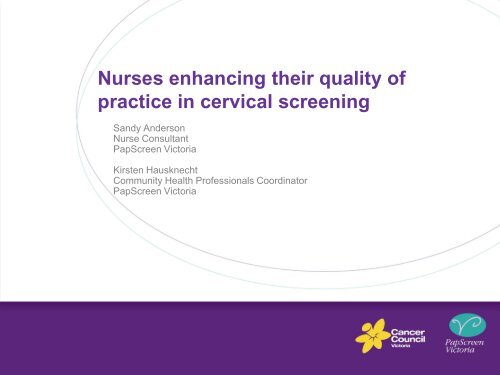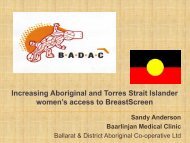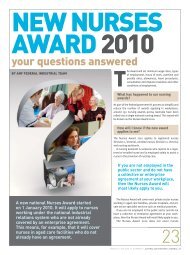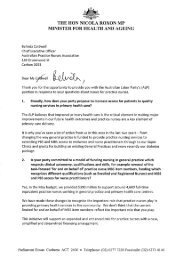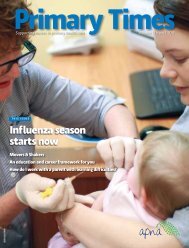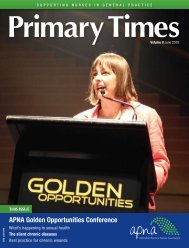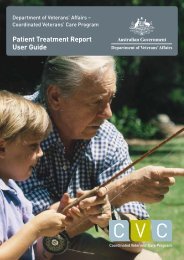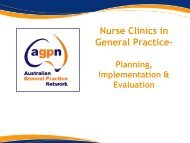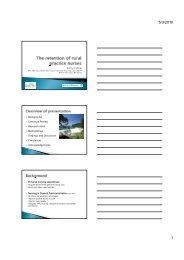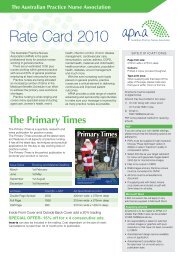CALD identification questions - APNA
CALD identification questions - APNA
CALD identification questions - APNA
You also want an ePaper? Increase the reach of your titles
YUMPU automatically turns print PDFs into web optimized ePapers that Google loves.
Nurses enhancing their quality of<br />
practice in cervical screening<br />
Sandy Anderson<br />
Nurse Consultant<br />
PapScreen Victoria<br />
Kirsten Hausknecht<br />
Community Health Professionals Coordinator<br />
PapScreen Victoria
Today, we will be covering the following:<br />
• Overview of PapScreen Victoria and the Identification Project<br />
• How the project lead to the Statistical Record worksheet<br />
• Using the worksheet and the recent changes to practice<br />
nurse funding to your advantage and enhance your clinical<br />
practice
How does PapScreen Victoria operate<br />
• Based within Cancer Council Victoria<br />
• Run public awareness campaigns<br />
• Work with health professionals to ensure Pap tests are as<br />
accessible and stress-free as possible for women<br />
• Find out what women think about Pap tests, and use this<br />
research to inform our work<br />
• Aim to reach unscreened and underscreened women:<br />
– Older women<br />
– Koori women<br />
– Lesbians<br />
– Women with disabilities<br />
– Women from diverse cultures<br />
– Women from low socio economic status
Victoria’s Cancer Action Plan 2008 - 2011<br />
One target was the need to develop systems to measure<br />
baseline <strong>identification</strong> data for Aboriginal and Torres<br />
Strait Islander (ATSI) and Culturally and Linguistically<br />
Diverse (<strong>CALD</strong>) groups in cervical screening.<br />
A partnership was formed in 2008 including:<br />
• Victorian Department of Health<br />
• Victorian Aboriginal Community Controlled Health<br />
Organisation<br />
• PapScreen Victoria<br />
• Victorian Cytology Service<br />
• Victorian Cervical Cytology Registry
Recording of ATSI <strong>identification</strong> data pilot<br />
• Phase 1 of the project commenced with Victorian<br />
credentialled cervical screening nurses recording<br />
ATSI <strong>identification</strong> data in September 2008<br />
• 287 nurses who use Victorian Cytology Service<br />
(VCS) participated in the pilot<br />
• Cultural awareness training was provided regarding<br />
how to ask the question<br />
• ATSI <strong>identification</strong> question added to the VCS<br />
pathology request forms<br />
• 48% of the nurses recorded ATSI data during the pilot
ATSI <strong>identification</strong> question<br />
Is the patient of Aboriginal or Torres<br />
Strait Islander origin<br />
□<br />
□<br />
□<br />
□<br />
Aboriginal<br />
Torres Strait Islander<br />
Aboriginal and Torres Strait Islander<br />
Not Aboriginal or Torres Strait Islander
<strong>CALD</strong> <strong>identification</strong> <strong>questions</strong><br />
In which country was the patient born<br />
………………………..<br />
Does the patient speak a language other than English at<br />
home (If more than one indicated the one spoken most<br />
often.<br />
□ No, English only □ Yes, other<br />
…………………………………………………………………<br />
Please specify<br />
…………………………………………………………………
Collection of ATSI <strong>identification</strong> data increased<br />
• The pilot evaluation identified collection rates<br />
increased with additional education and training<br />
• PapScreen Victoria included training information in all<br />
professional development workshops held in 2010<br />
• The impact of the training increased the average<br />
ATSI collection rate for nurses to 67.5% in 2010<br />
• ATSI and Culturally and Linguistically Diverse<br />
(<strong>CALD</strong>) <strong>identification</strong> data collection was included in<br />
the recredentialling process from 2012
Percentage of ATSI <strong>identification</strong> data collected<br />
48% 49%<br />
67%<br />
87%<br />
Year<br />
Data provided<br />
by VCS 2012
Country of birth and language spoken at home<br />
<strong>identification</strong> data collected in 2011<br />
Data provided<br />
by VCS 2012
Nurses who use private pathology services<br />
• All nurses are required to collect ATSI and <strong>CALD</strong><br />
<strong>identification</strong> data, including nurses who practice under a<br />
doctors name using a private pathology company<br />
• Previously nurses mainly kept a paper record of their<br />
cervical screening data to use when they recredentialled<br />
every three years<br />
• PapScreen Victoria developed an electronic worksheet.<br />
The worksheet enables reporting facilities to assist all<br />
nurses to be able to report on their own general practice<br />
population and cervical screening reach
PSV worksheet<br />
reporting features:<br />
general summary
PSV worksheet<br />
reporting features:<br />
<strong>CALD</strong> summary
Changing role of the general practice nurse<br />
Operating roles of the practice nurse –<br />
1. Patient carer<br />
2. Organiser<br />
3. Quality controller<br />
4. Problem solver<br />
5. Educator<br />
6. Agent of connectivity<br />
C Philips et al. 2009 “Enhancing Care, improving quality: the six roles of the general practice nurse”<br />
A study in 2011 found only 6% of nurse activities<br />
generated a fee<br />
C Pearce et al. 2011 “Following the funding trail: Financing, nurses and teamwork in Australian general practice”
Overview of the Practice Nurse Incentive<br />
Program<br />
• PNIP introduced 1 January 2012<br />
• Supports role of Registered & Enrolled nurses, and<br />
Aboriginal Health Workers in general practice<br />
• Allocated according to nursing hours<br />
• Allows the opportunity for nurses to further develop<br />
their role within primary health care
Advancing the role of the practice nurse<br />
• The PNIP is creating an opportunity for nurses to<br />
promote advanced nursing skills within the general<br />
practice team<br />
• Opportune time to commence specialised nurse<br />
clinics such as Women’s Health / Pap clinics<br />
• Enables specialised care which targets your specific<br />
client population
Why start a Women’s Health / Pap clinic<br />
• Nurses are more likely to take a Pap test from<br />
women who are underscreened (over 2 years) – 66%<br />
compared with 57.9% for other providers<br />
• Nurses collect 36.8% of all Pap tests from women<br />
aged 50 – 69 years, compared to 30.1% from other<br />
health providers<br />
• Pap tests conducted by nurses record a higher<br />
technically satisfactory result<br />
• Nurse cervical screening providers have been vital in<br />
the Identification Project
Evaluating your practice<br />
Evaluating your practice and participating in quality<br />
improvement equates to Continuing Professional<br />
Development hours.<br />
Examples:<br />
• Satisfaction survey<br />
• Clinical Audit tool<br />
• Worksheet<br />
• Credentialling
Building your practice<br />
By understanding the demographics of your practice you<br />
are able to advocate for your practice with:<br />
• General practitioners in your practice<br />
• Practice managers<br />
• Practice meetings<br />
• Medicare locals<br />
• Accreditation body<br />
• Media – report your practice initiatives<br />
• Colleagues<br />
• Networking
Contact details<br />
Sandy Anderson<br />
Nurse Consultant<br />
0407 190 207<br />
sandya@ncable.net.au<br />
Kirsten Hausknecht<br />
Community Health Professionals Coordinator<br />
03 9635 5403<br />
kirsten.hausknecht@cancervic.org.au
www.papscreen.org.au


